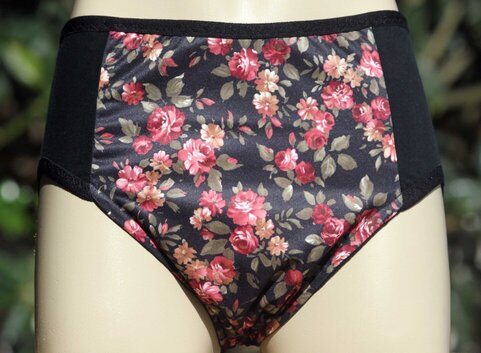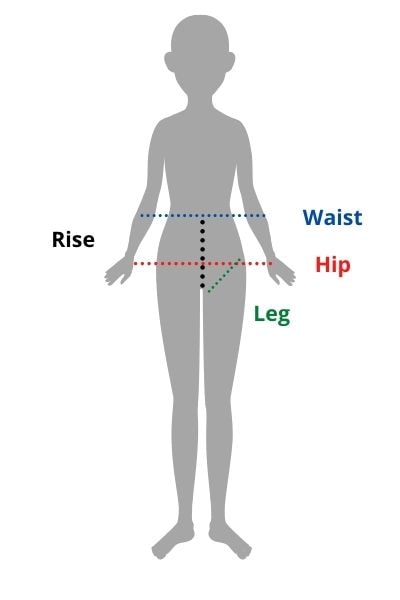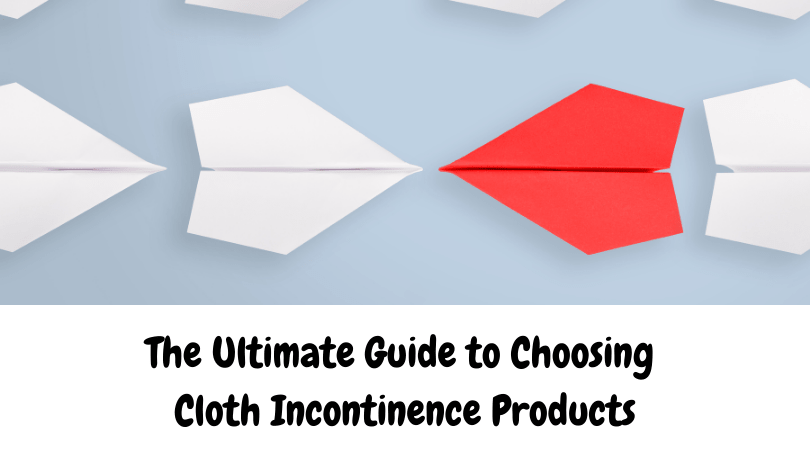Take a deep breath in. Exhale.
Okay. Let’s have a moment of truth. Disposable diapers and disposable underwear are the same thing (dunderwear?). If you feel strongly enough about this to dispute me, please share your wisdom.
In the disposable incontinence product world, there are diapers and pads.
In the cloth incontinence product world, on the other hand, there are pads, panties, absorbent briefs, pull ups, and a million different styles of diapers. Not to mention the colors! The patterns! Oh my!
It makes the disposable world feel positively monochromatic. But if that’s your thing, I’m not here to judge. Trust me, I’ve heard IT ALL.
But while it is undoubtedly awesome that the cloth incontinence product world offers so many options, it also makes choosing a little more complicated.
It turns out that this conundrum has a name, choice overload. Just like everything else in life, choices in moderate numbers lead to most successful outcomes. Also, as the researchers found, if there is a preferred alternative, your brain is able to handle more choices.
For example, I recently was looking to buy ceiling fans for the upstairs of our 150 year old stone house. I knew three things. One, my husband wanted them to look the same (we needed 2 different sizes). Two, no bare bulbs, and three, the style needed to compliment the historical architecture of the house.
I shudder to think of the hours I spent spiraling through rabbit hole after rabbit hole of options. The colors! The patterns! Oh my!
And here I thought that interior design was supposed to be the fun part of fixing up a house…*face palm*

But once I narrowed it down even further – farmhouse, light wood looking blades, silver finish – it was insanely easy to make the choice. Of course, it only took 7 months to choose because I felt so overloaded with all the options in the beginning.
But the point is, once I figured out what I was looking for, choosing was a breeze.
Your needs and your lifestyle will determine which types of incontinence products will work best for you.
Once you choose a product, then that becomes the springboard on which to make subsequent decisions. But here’s a peek into my tried and true framework that I’ve used to help dozens of my customers find the right products for them and their loved ones.

Step 1: Function
If you have unlimited funds and time and are a “buy everything! Try everything!” type of a person, you get the luxury of unlimited trial and error. For the rest of us mortals, however, having a place to start can significantly reduce the need for trial and error – and save money (hallelujah!) – on the way to finding the ideal product.
So first things first.
-
- What are your needs?
Maybe you have a medical diagnosis that will make determining this easy – or maybe you don’t. That’s okay. Sometimes definitions can be more distracting than helpful unless you’re in the land of denial with your body. In this case, definitions can be helpful in yanking your head out of the clouds and back into stone cold reality.
I don’t mean to be callous. Just practical.
After all, if you think that the level of your incontinence is mild, but you keep ending up with leak lines on your pants or wet spots on your bed – or that of someone you care for – then your incontinence level is probably higher and you need to up the level of absorption.
But the converse is also true. Maybe the situation you’re in is more mild, but you keep on keepin’ on with bulky, uncomfortable products when you could be using a lighter, less obtrusive product.
- What is your lifestyle?
I feel like this question often gets overlooked. Choosing a product based on your needs only without consideration of your lifestyle may land you in some awkward situations.
You may think you need a front closure diaper for your more heavy moderate incontinence, but you can still use the bathroom. Maybe you don’t make it all the time, which is why you need an incontinence product, but still.
My point is, you don’t want to find yourself on the regular in front of the toilet with a front closure diaper wondering how you’re going to get it off to pee without dropping it on the floor or in the toilet. You’ll be better off with a lighter, easier to use item for daytime and saving the fitted for night.
Sorrynotsorry if that’s TMI, but glossing over the awkward stuff isn’t going to help anyone.
If you’re a caregiver, you need to take into consideration the abilities of the person you’re caring for. Are they bedridden? Can they stand? What tasks are they able to do on their own?
So knowing your lifestyle is the second step in figuring out how you need a cloth incontinence product to function.
To determine how a product should function for your unique situation, you need to know both your needs AND your lifestyle.
Step 2: Fashion
Now for the fun part! Choosing the actual product.
Once you’ve figured out your needs and lifestyle, you can get to shopping and only focus on a narrowed line of options. This is the “preferred alternative” in the whole making choices thing. This will help you navigate the colors! The patterns! Oh my!

Now, don’t go and say that all the choices are lame and boring. That’s just blasphemy and you’re obviously looking in the wrong places. Though I get it. I’ve been on those medical supply sites and the whole adult cloth diaper sites and yes, their choices are definitely uninspired.
But fashion is waking up to the fact that incontinence is a very common thing and you can find so many more choices today than ever.
Though, a lot of my customers like white. White is easy to wash and won’t color bleed.
On the other hand, a lot of my customers share the mindset that if you have to wear an incontinence product, you might as well have fun with it.
I once asked a customer what color they wanted their item to be, and he responded by saying, “pink.” Not one to judge and acclimated to the fact that pink is VERY popular among a certain set, I went ahead and ordered the fabric.
When I touched base with him later to double check measurements, I told him I had ordered the pink fabric. He was mortified and told me he was joking about choosing pink!
But he said his wife thought it was hilarious, so he was going to go with it anyway and that if he had to wear one, he might as well have fun with it.
Just saying.

Step 3: Fit
Now that you’ve figured out your needs and chose a product to try out, next you need to make sure it fits.
And I don’t mean just that you can get it on and it stays on. Though that’s always nice.
I’ll take a gander that you don’t need me to tell you that leaks are the curse of incontinence and that obviously you want to ensure that no leaks get on clothes, furniture, etc.
So, fit.
In order to not have your chosen product leaking where you don’t want it, you need to make sure that it fits not only on, but that it’s snug enough around the leg openings. You want it to fit tightly enough that there’s no gaping, but not so tight that you end up with red marks on your skin.
Of course, you may still experience leaks. These can most often be remedied by changing more frequently or adding an insert for more absorption.
In the end, taking the time to go through the three F’s will help you to narrow down what type of product will work for you and your life. This will streamline the decision process, making it easier to actually decide on a particular product and design.
Which is good because while deciding to use cloth is awesome, if you don’t actually decide on a product to buy, that first decision isn’t helpful except to make you feel bad about yourself.
Anyway, if you find this information to be helpful, but want to go more in depth or would like a little hand holding through the process, check out my upcoming workshop “Switching to Cloth Incontinence Products.”
In this workshop, I’ll walk you more in depth through the 3 F’s process and further into my full framework where we discuss items that help make using cloth incontinence products easier, as well as how to create habits that will ensure making the switch will be successful.
Alecia
Latest posts by Alecia (see all)
- Why Little Onion is Not ABDL - November 1, 2024
- Best Adult Diaper Covers - March 7, 2024
- Best Fabrics for Making Adult Diaper Covers - February 16, 2024


